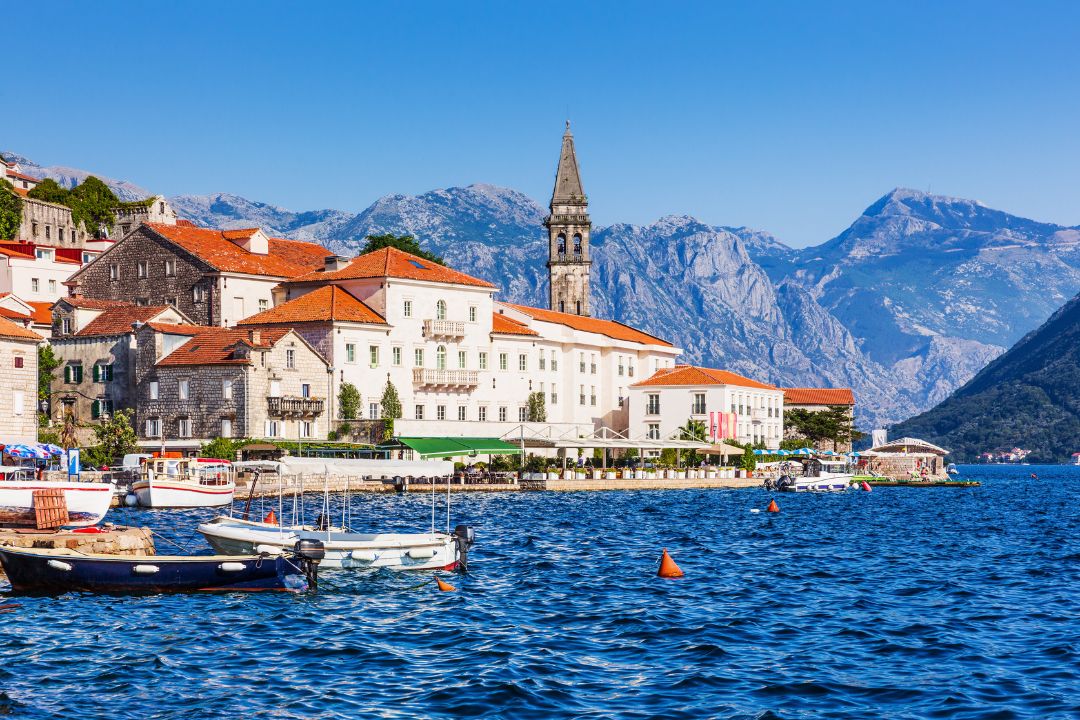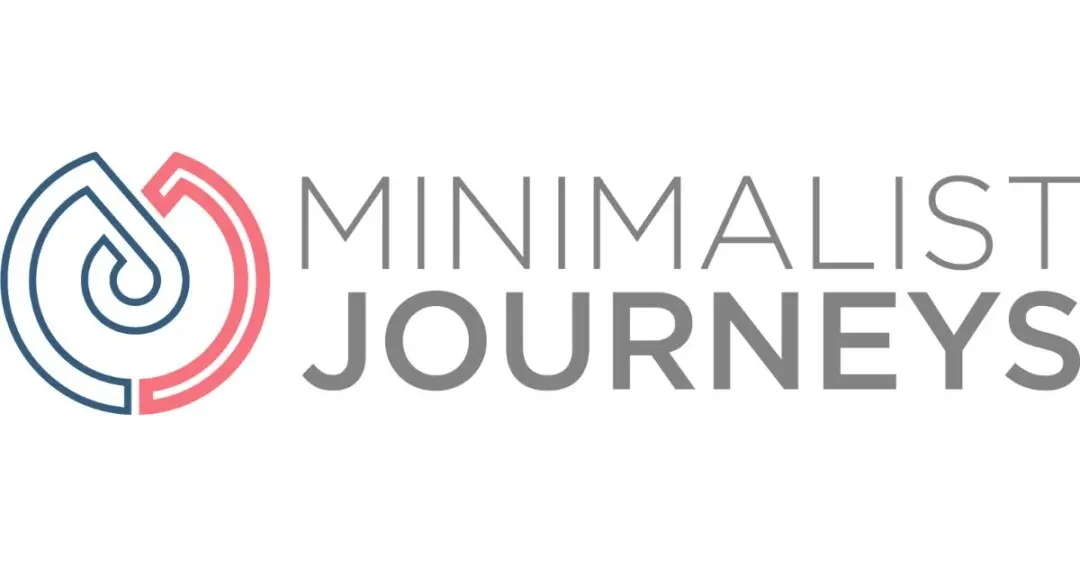This article may contain links to products and services we use and recommend. We may receive compensation when you click on links to those products. For more information, see our Disclosure Policy.
If a country has mountain in its name, can you guess its main topographical feature? Of course. But with towering mountains, you also get deep river gorges, stunning lakes and a beautiful rugged coastline along the Adriatic. Welcome to Crna Gora/Montenegro (which means Black Mountain).
Today’s article is jam-packed with all the key things you need to know to explore this fascinating country – at your own pace and without a car. We even put together an itinerary that takes you to all our favourite spots in 14 days (or more). Montenegro has everything you need, whether you love the great outdoors, history, or delicious food.

Thanks to its mountainous topography, Montenegro also has stunning river gorges and lakes
Montenegro – Key things to know
Entry Requirements
For most visitors, entry is visa-free for up to 30 days with a valid passport. Check Montenegro’s Ministry of Foreign Affairs website for up-to-date information on your country.
Travel Safety
Apart from the occasional scam and pick-pocketing, Montenegro is a safe country to visit. Check out our general tips on staying safe while travelling and what to do if something does go wrong.
Water Quality
We found tap water to be fine to drink (it’s even served alongside coffee or wine in restaurants), but the HPA advises against drinking tap water in Montenegro. Boil water or bring a water treatment kit to be safe.
Currency
While not a EU member, the Euro (EUR) is the official currency of Montenegro.
Public Holidays
When planning your trip, be aware that some services won’t be available on these public holidays.
Electricity
Montenegro uses 230V/50Hz Continental European C/F Type plugs.
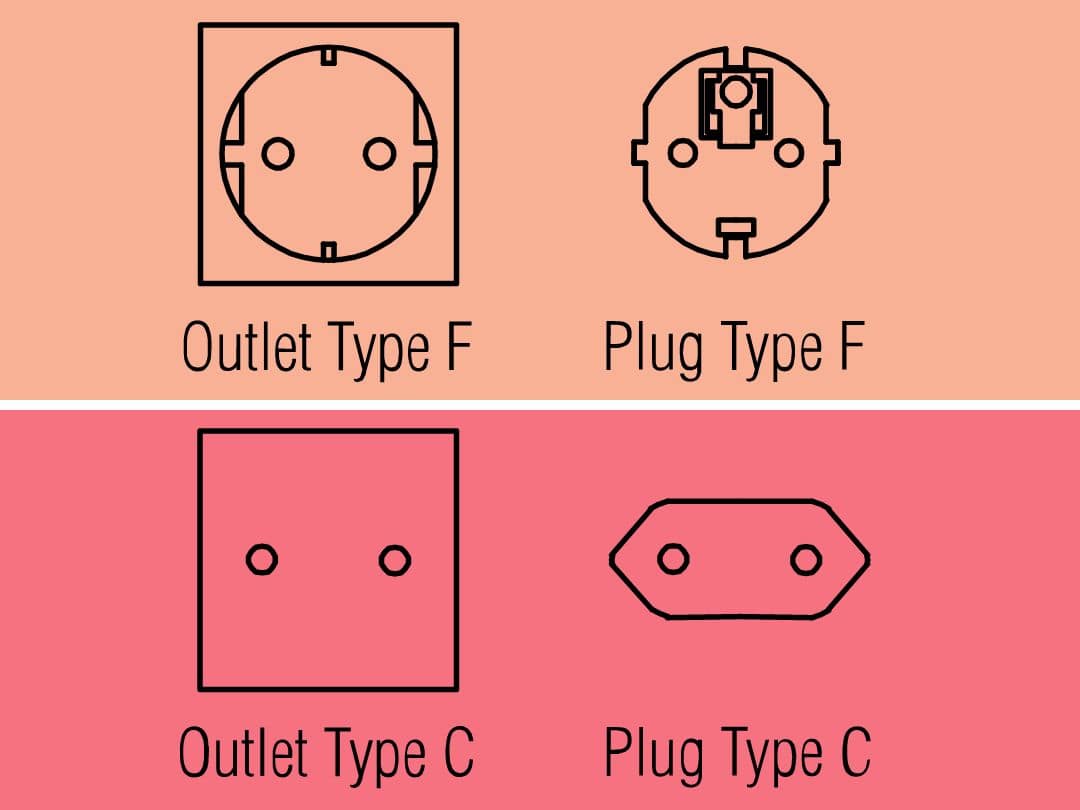
Language
Montenegrin is the official language – essentially the same language as spoken in the other countries of former Yugoslavia. Both Latin and Cyrillic alphabets are used, but Latin is more prevalent. Near the border to Albania, street signs are bilingual: Montenegrin and Albanian.
What Else
In Montenegro, like all Balkan countries, smoking is still commonplace. While smoking has been banned in all closed public places (including restaurants and cafes) since 2019, the law is rarely enforced.
Likewise, sustainability is still in its infancy: plastic bags/straws and no waste separation are the norm. Do your bit by trying to avoid plastic/packaging in the first place.
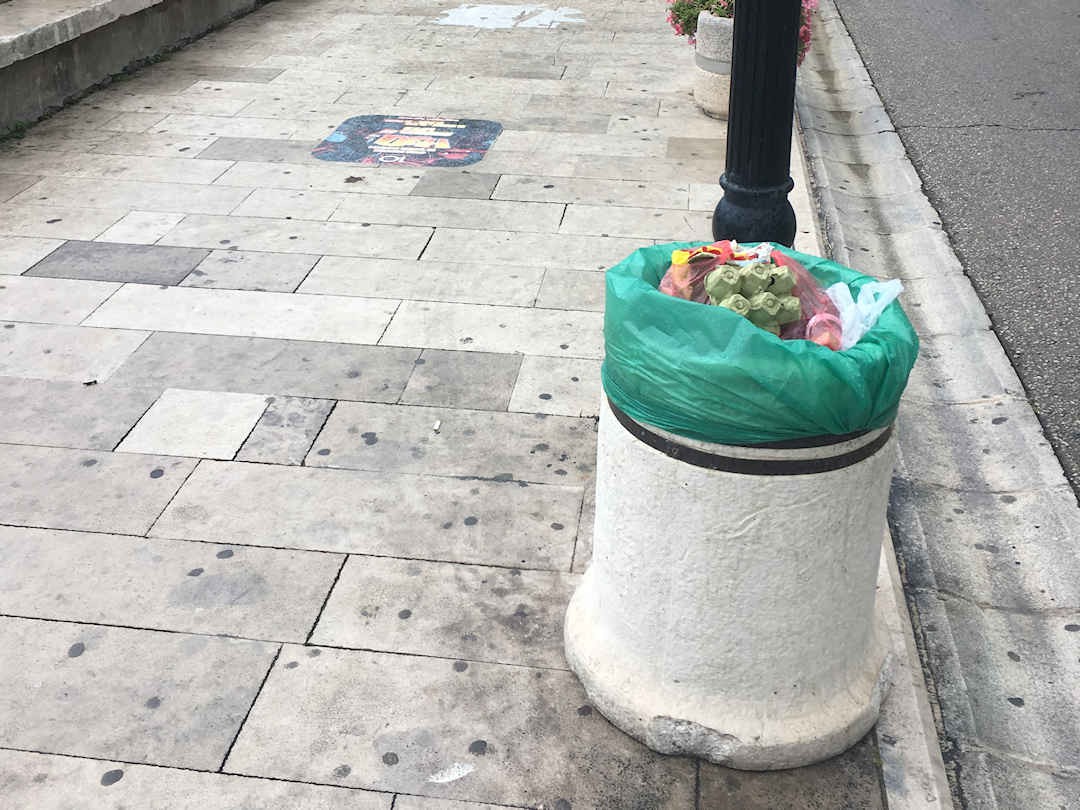
There is no garbage separation in Montenegro, so do your bit by avoiding packaged food in the first place
Best time to visit Montenegro
When to visit Montenegro generally depends on where you want to go:
- If you want to explore the Adriatic coast, avoid the European summer holidays, especially July and August when Serbian and Russian families flock to the Adriatic (and you have a gazillion cruise ships anchored in the Bay of Kotor).
- If you want to hike in the mountainous national parks, avoid the winter months (November to March), as the trails are inaccessible.
May, June and September are great months to explore the country. Temperatures are pleasant, with good chances for clear, sunny days and fewer crowds. Check out Weather Spark for year-round climate information on Montenegro – you can change your destination at the top right.
If you want to explore Kotor and the surrounding area, you may also want to time your visit when there are no cruise ships in port (or at least only one). The old town of Kotor is very small, and it’s a very different experience with(out) thousands of cruise ship tourists.
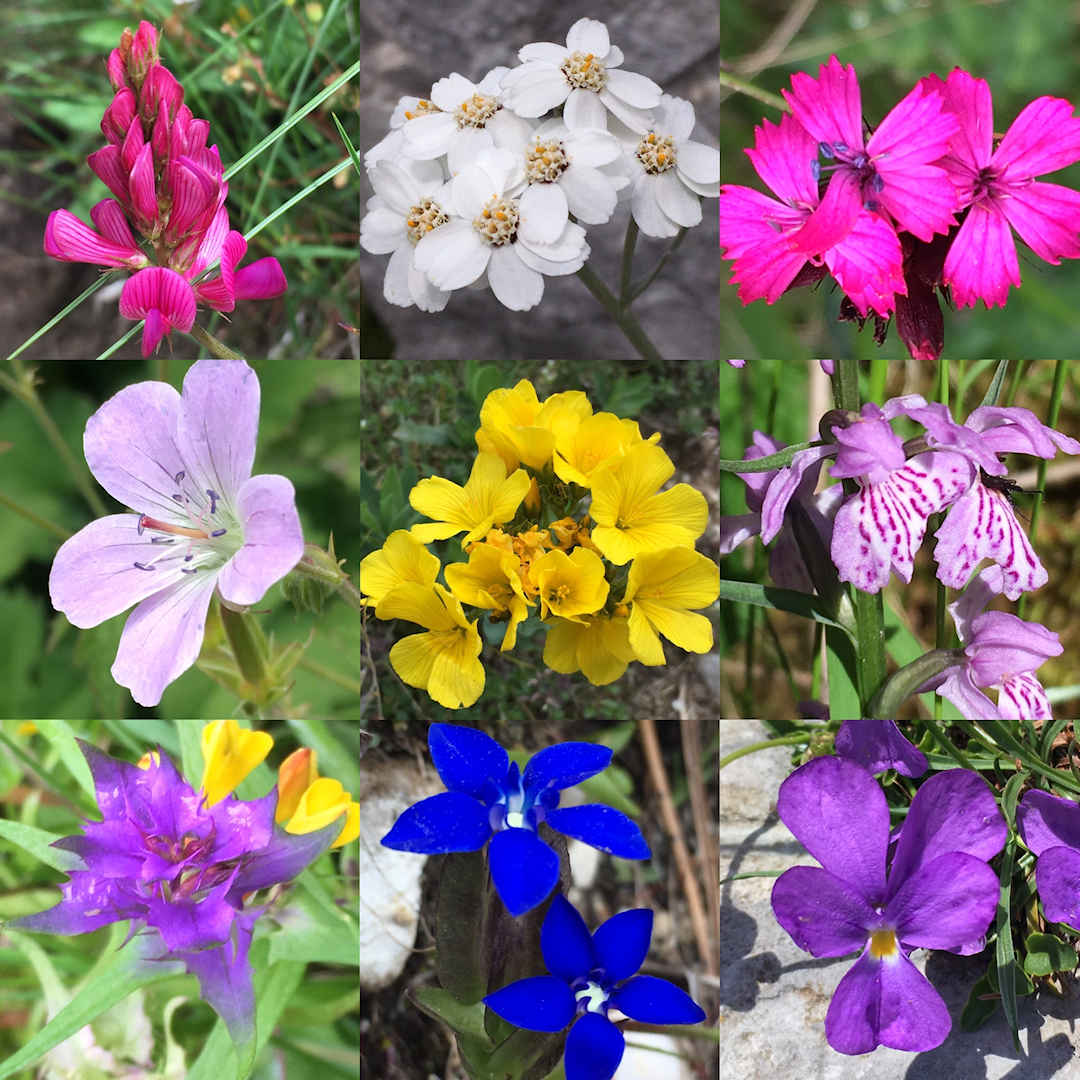
Spring is an excellent time to visit Montenegro and enjoy pleasant temperatures, fewer crowds and blooming wild flowers
How to get to Montenegro
Montenegro has two international airports – in the capital, Podgorica, and Tivat, in the Bay of Kotor:
- Podgorica (IATA: TGD | Official website | Google Maps location) is serviced year-round by nonstop flights from Europe, the Middle East, the South Caucasus, and Central Asia.
- Tivat (IATA: TIV | Official website | Google Maps location) has a limited number of year-round flights from other European destinations but gets very busy during the summer, with seasonal flights from all over Europe, the Middle East and the South Caucasus.
Another option is to fly into and out of Dubrovnik (IATA: DBV | Official website | Google Maps location) in Croatia. The airport is less than 20km from the Montenegrin border. I recommend the transfer service from Dubrovnik Airport to Kotor using HappyToVisit.
For the best prices on airfares, we recommend to check Skyscanner.
How to get around Montenegro (without a car)
You don’t need a car to explore Montenegro. While the country is mountainous and journeys take longer, travelling around Montenegro by train and bus is feasible and allows you to thoroughly enjoy the stunning scenery. At the same time, someone else has their eyes pinned on the road (or tracks).
Train travel in Montenegro
Let’s start with the easy one. There are only two railway lines currently operating in Montenegro; both are run by state-controlled rail transport operator Željeznički Prevoz Crne Gore (ZPCG):
- the line that connects the seaside town of Bar (and Montenegro’s capital, Podgorica) with the Serbian capital, Belgrade (we share our experience making the journey in our Bar-Belgrade Railway guide), and
- the train line between Podgorica and Nikšić (which passes through the valley below the Ostrog Monastery – learn about a day/overnight trip to this holy site in our Cetinje travel guide).
The ZPCG website has up-to-date timetables (and fares). Tickets can be bought at all train stations and from the train conductor.
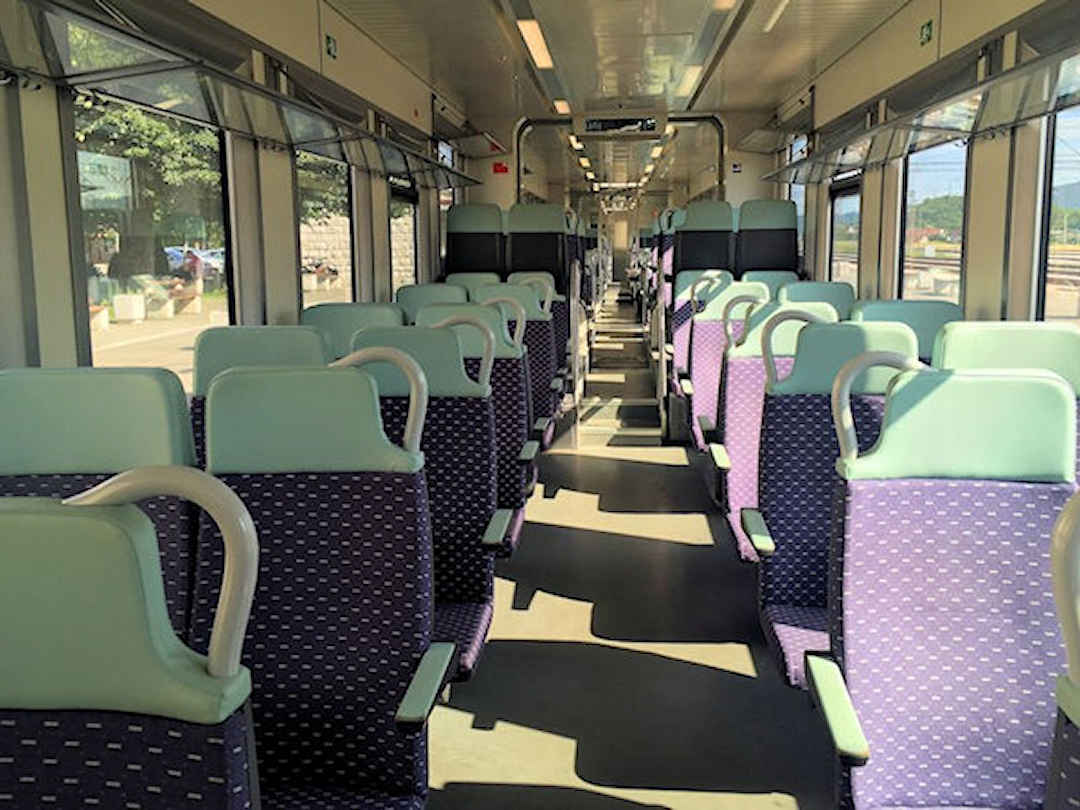
Train travel in Montenegro is surprisingly comfortable
Bus travel in Montenegro
We found Busticket4Me most beneficial when it came to finding timetables and fares. You can even book bus tickets online. Just be aware that you still need to
- check-in at the bus station (and pay a station fee)
- print off your bus ticket if you have ordered it online (possible when you check in and usually included in the station fee), and
- pay a luggage fee if you put your luggage in the hold.
The station and luggage fees are only a Euro each (per person and item, respectively).
Buses stop frequently and can be waived down at stops along the roadside. In this case, you pay your fare (including the luggage fee) on the bus.
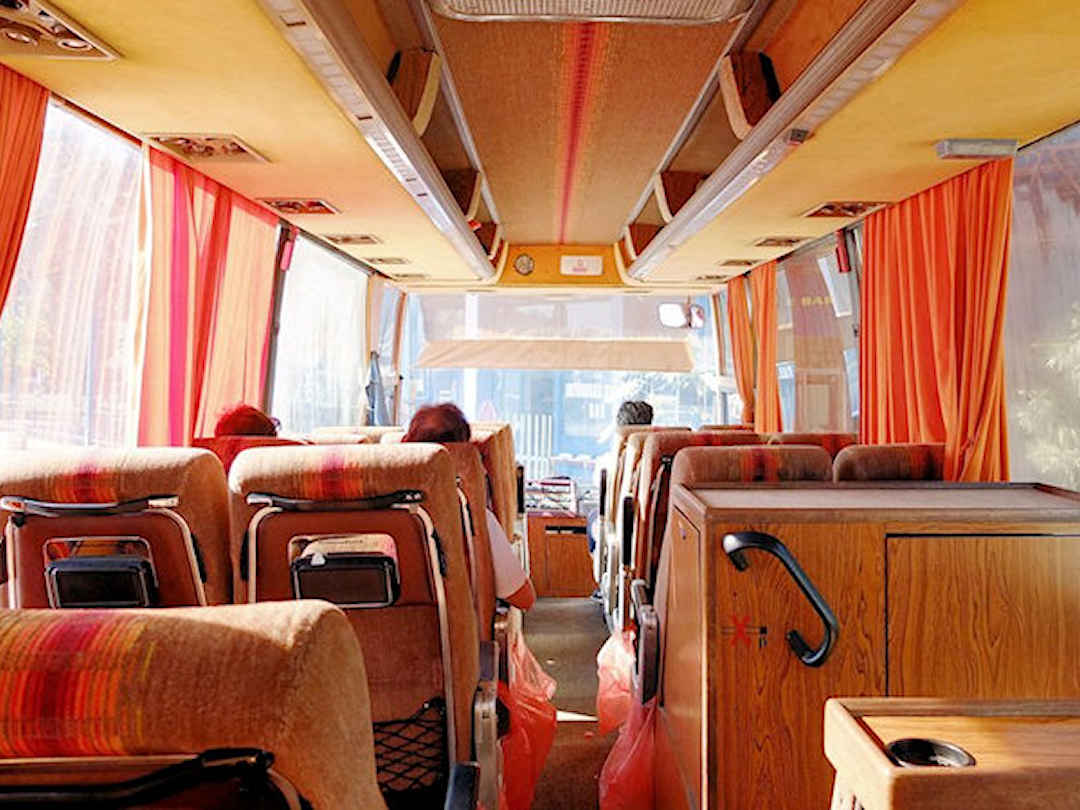
It may not be the most modern but Montenegro has an extensive bus network | Image courtesy of Victoria Kure on Unsplash
Taxis and Rental Cars in Montenegro
Taxis and rental cars are good options where buses and trains don’t go frequently (and it’s too far to walk or cycle):
- Base rates for taxis are usually EUR1-2, depending on location, plus EUR1 per km. Unless you take a taxi in a larger city, be prepared to pay cash, as many taxi drivers prefer cash and don’t accept card payments.
- You don’t need to hire a car for your entire trip around the country. We only hired one twice – for a day to explore the area around Kotor and for two days to explore the area around Bar and Skadar Lake.
If you’re driving yourself, be aware that many roads are windy and, at times, very narrow. Drivers in Montenegro tend to be more erratic. If you get caught in an accident, call the police and get a report for your rental car provider’s insurance—no matter where or how minor (we learned that the hard way).
How to find the best deals on rental cars
Most of the time, we use public transport to get us around. But occasionally, hiring a car or scooter just makes it easier or gets us to places we couldn't go without a set of wheels. Whenever we do hire a vehicle, our first point of call are local rental providers. A quick Google Maps search shows who's near us. We then check the reviews and only contact those other travellers had good experiences with.
If we can't find anyone we're comfortable with, we search for deals on aggregator websites. We've used Rentalcars.com and DiscoverCars.com in the past and had only good experiences with them. Both partner with trusted brands like Hertz, Avis, Budget or Europcar (and in some locations even local providers) - so you can compare car hire options in a similar way you'd compare accommodation offers across Agoda and Booking.com.
How much should the budget be for Montenegro?
We found Montenegro reasonably affordable compared to the USA, England, Australia, and New Zealand. For all the details on what to consider for accommodation, food, transportation, and experiences and how to save a buck or two, check out our Travel Budget Guide for Montenegro.
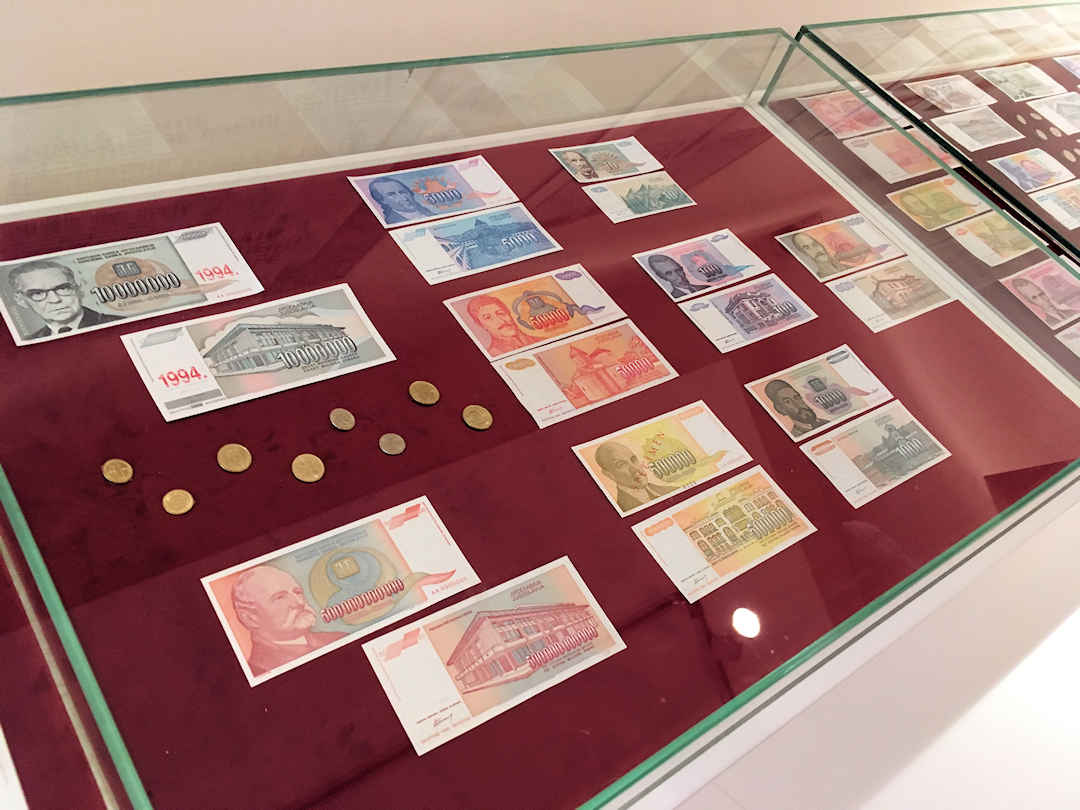
Do you know why Montenegro uses the EUR without being a EU member state? Find the answers at Cetinje's Money Museum
Your ultimate 14-Day Montenegro itinerary
Our self-guided itinerary takes you from the fjord-like Bay of Kotor and Montenegro’s old capital, Cetinje, to the coast of the Southern Adriatic and the water lilies and bird life of Skadar Lake. Then, we head inland on a breathtaking rail journey through deep river gorges and high up into majestic mountains with crystal-clear lakes and challenging hiking and mountain bike trails. Sounds awesome? Let’s get into it.
We recommend to divide your 14 days into 3-4 night stays in four different locations:
| Destination | Minimum number of nights recommended |
|---|---|
| Bay of Kotor (Kotor, Perast and Risan, with option to visit Tivat) | 3 |
| Cetinje (with day trip/s to Lovćen National Park and Lipa Cave or Ostrog Monastery) | 3 |
| (Stari) Bar, Ulcinj and Skadar Lake National Park | 3 |
| Half-Day trip on the Bar-Belgrade Railway | N/A |
| Žabljak, Durmitor National Park and Tara River Canyon | 4 |
Map of Accommodation, Points of Interest, Eateries and Transport
Below is a map of the recommended accommodations, points of interest, eateries, and transport terminals or stops mentioned in this article.
Days 1-4: Bay of Kotor
Let’s start with the journey from the airport to your first stop – Kotor.
Tivat Airport (TIV) to Kotor
Taxis and private shuttles between Tivat Airport and Kotor start at EUR30. You can book one in advance with SunTransfers. To save some cash, walk to the Tivat Bus Station [Google Maps location] – a flat 1.5 kilometres / 20 minutes along a busier road – and take the bus to Kotor. Bus fares cost around EUR3 (plus station and luggage fees). Taxis and intercity buses travel through the tunnel between Tivat and Kotor, with taxis taking 10-15 minutes to Kotor Old Town, pending traffic, and buses around 20 minutes to the Kotor Intercity Bus Station [Google Maps location].
Podgorica Airport (TGD) to Kotor
Taxis and private shuttles between Podgorica Airport and Kotor start at EUR85 (and take around 1 1/2 hours, pending traffic). You can book one in advance with SunTransfers. To save some cash, take a bus from the Intercity Bus Station in Podgorica [Google Maps location] to Kotor (EUR8-9 plus fees, about 2 hours). To get to the airport’s bus station, take a taxi (costs EUR12) or the train to Podgorica (EUR2). The little train station outside the airport [Google Maps location] is a flat 1.5 kilometres / 20 minutes walk away along the quiet airport road (stay to the left of the road bridge that crosses the tracks). Check the ZPCG website for departures (from Aerodrom to Podgorica), as trains aren’t as frequent (and often late).
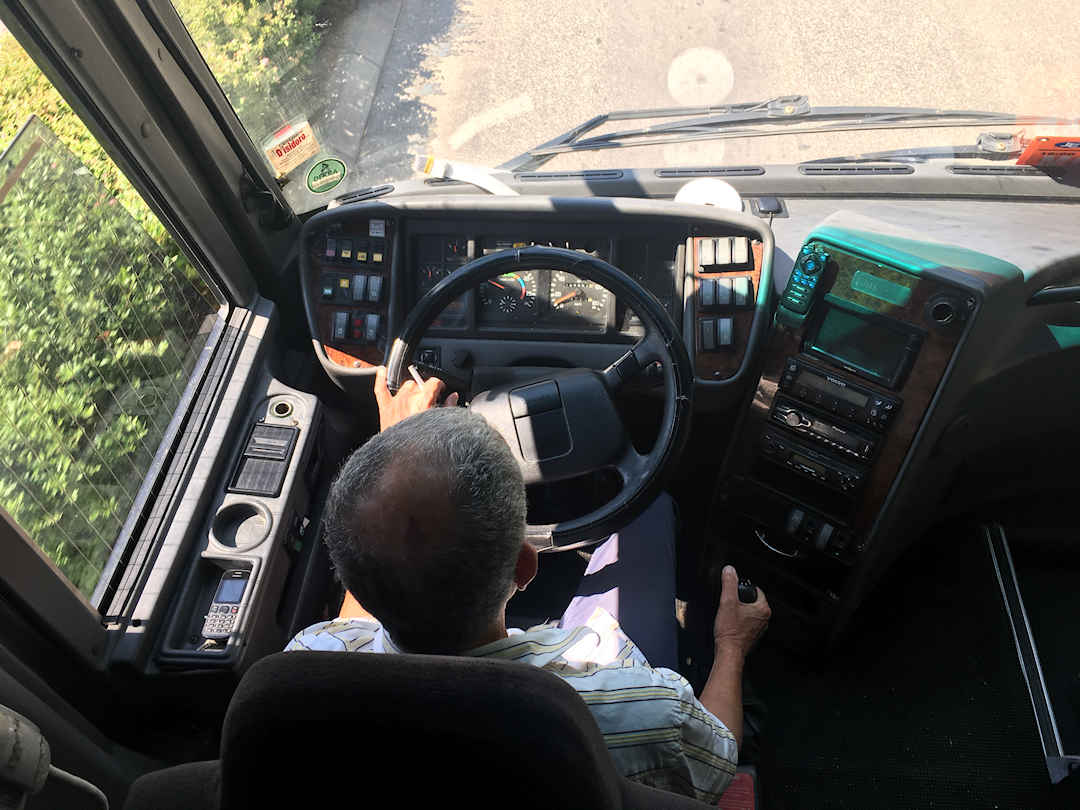
Unlike elsewhere in Montenegro, smoking is not allowed on buses - though this Jadran Ekspres driver didn't care
Dubrovnik (DBV) to Kotor
There is no direct bus service between Dubrovnik Airport and Montenegro, so you’d have to first travel to Dubrovnik’s Intercity Bus Station [Google Maps location], using the public Libertas bus (routes 11, 27 or 38) or the Platanus Airport Shuttle. The bus service from Dubrovnik to Montenegro is not the best – overbooking and long delays are frequent. We even encountered a bus driver who smoked while steering the bus – not much fun if you’re a non-smoker sitting right behind them. Thus, the most sensible transfer mode from Dubrovnik Airport to Montenegro would be a taxi/private transfer. You can book one in advance through Happy To Visit.
What to see and do in the Bay of Kotor
Kotor’s UNESCO-listed Old Town is a maze of medieval charm. Begin with a (self-guided) walking tour exploring its narrow alleyways, historic squares and centuries-old churches. Take a boat trip to the iconic Our Lady of the Rocks islet, or explore Perast, with its long maritime history, and Risan, a Roman archaeological site nearby. Embrace nature by hiking a myriad of hiking trails (including the steep but rewarding climb to San Giovanni Fortress). In the evenings, enjoy local seafood and Montenegrin wine at family-run konobas, supporting local businesses.
To enjoy the Bay of Kotor at its best, avoid days when cruise ships anchor in the bay. For all our (other) tips read our Kotor Bay Travel Guide.
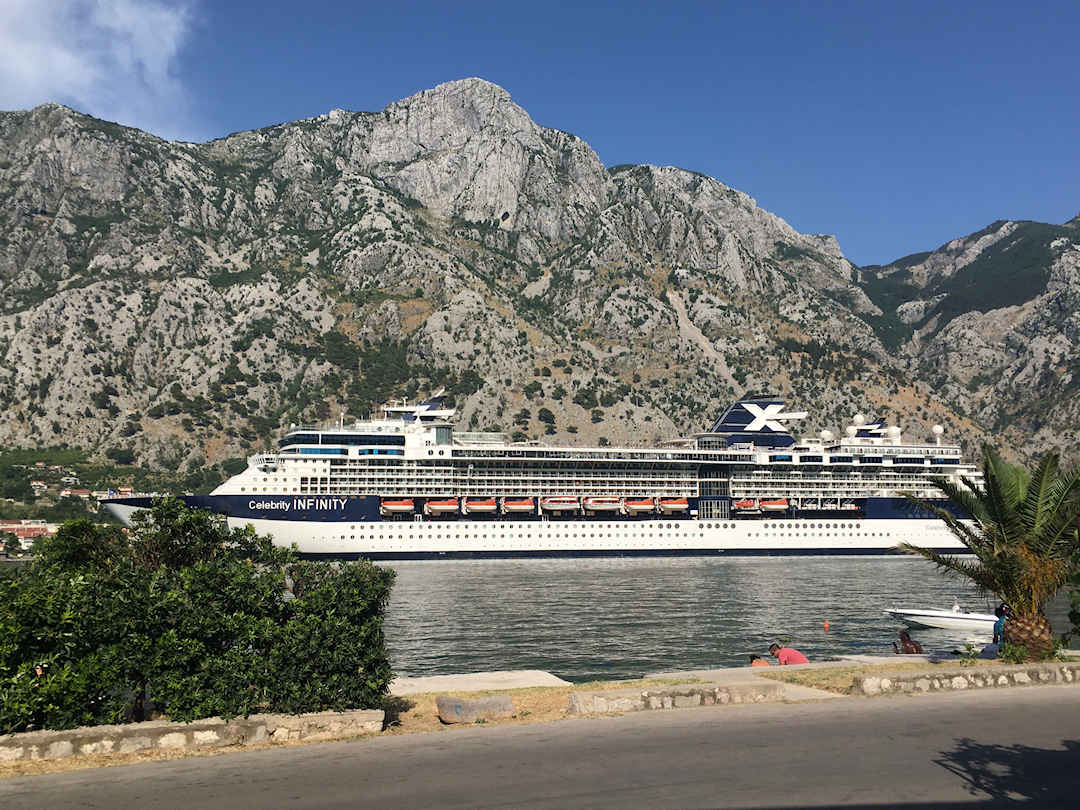
To enjoy the Bay of Kotor at its best, avoid days when cruise ships anchor in the bay
Where to stay in Kotor
Kotor is located at the southern end of the (inner) bay (which looks like a bow tie if you look at it on a map). There are literally hundreds of accommodation options dotted around this part of the bay, with local buses connecting Kotor and the villages along the bay shore. So, you don’t need to stay in the Old Town of Kotor, especially if you’re on a tighter budget.
| Name | Property Features | Type | Price Indicator | Book Now |
|---|---|---|---|---|
| Apartments Kaleta | City views, family friendly, kitchen facilities | Apartment | $$ | Book Now |
| Kotor Center W | Beachfront Allergy-free units | Apartment | $$$ | Book Now |
| La Rocca Apartment | Certain documented environmental practices implemented at property Historic building Inside the Old Town | One-bedroom Apartment | $$ | Book Now |
Where to eat in/around Kotor
Our top three eateries in and around Kotor were:
- BBQ Tanjga is an affordable and welcoming grill joint between Kotor Old Town and the Intercity Bus Station, serving traditional Balkan fare.
- Restaurant Mondo, a friendly waterfront eatery in Dobrota, serves delicious seafood dishes.
- Restoran Mademoiselle, our favourite in Prčanj, serves lunch, dinner, and a good selection of wines at the water’s edge.
Days 4-7: Cetinje
Kotor to Cetinje
Travelling to Cetinje—your second stop on our itinerary—is easy. There are frequent intercity buses between Kotor and Cetinje via Budva, and the journey takes about 1 1/2 hours.
What to see and do in Cetinje
Cetinje, Montenegro’s historic capital and cultural heart, is ideal for slow travellers seeking authentic Montenegrin experiences away from tourist crowds. Start your visit at the Cetinje Monastery and hike up to nearby Eagle’s Rock for sweeping views over the town and surrounding mountains. Wander past elegant embassies from Cetinje’s diplomatic heyday, and don’t miss the National Museum of Montenegro complex, where rotating exhibits highlight local art and history.
Cetinje also makes a great base for hiking or MTB adventures at nearby Lovćen National Park or a day trip to Ostrog Monastery, a spiritual symbol of Montenegrin identity. Stay in family-run guesthouses and enjoy local fare at konobas to support the community. For all our tips on the things to see and do in/around Montenegro’s old capital check out our Cetinje Travel Guide.
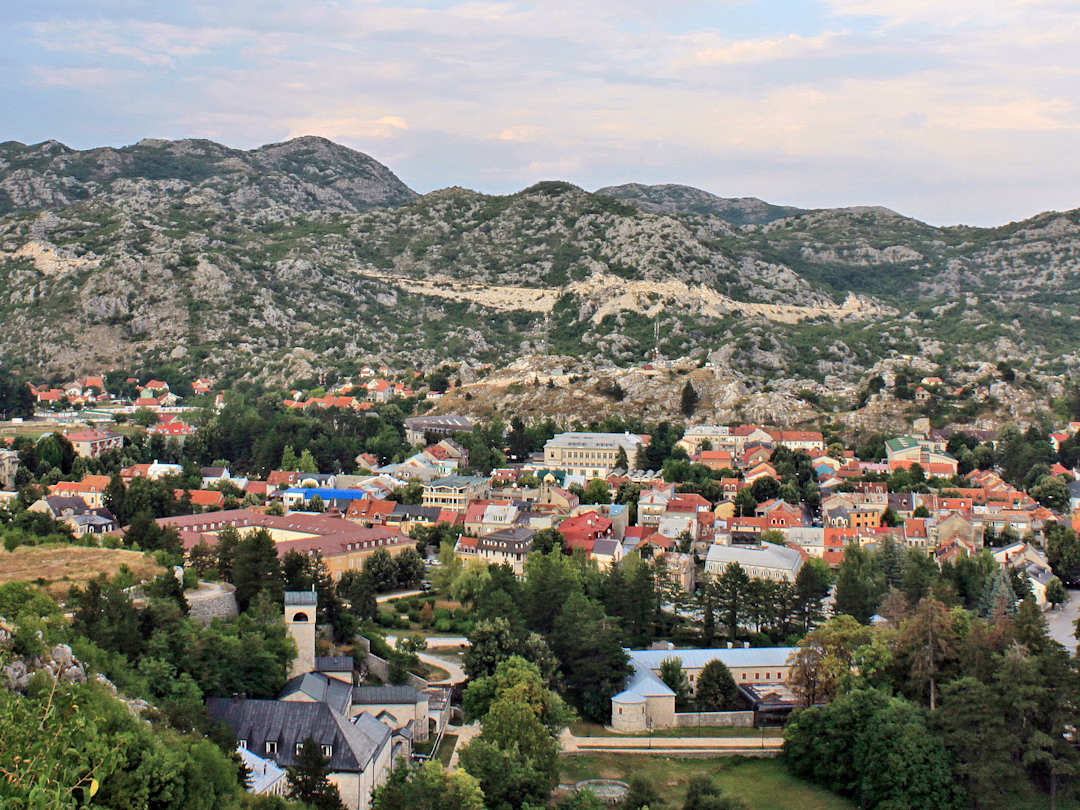
Cetinje is Montenegro's historic capital and absolutely worth a visit
Where to stay in Cetinje
Cetinje is easy to explore on foot or by bike, and you can even get to Lipa Cave by bike or explore the mountain bike trails in Lovćen National Park from here. I have therefore included accommodation options that provide a bike free of charge.
| Name | Property Features | Type | Price Indicator | Book Now |
|---|---|---|---|---|
| Apartman Donji Kraj | 24-hour front desk Fully equipped kitchen | Apartment | $$ | Book Now |
| Apartmani vuk | Excellent location 24-hour front desk Packed lunches are available | Apartment | $ | Book Now |
| Brvnara Borovik | Certain documented environmental practices implemented at property. Mountain and garden views | Family Bungalow | $$ | Book Now |
Where to eat in Cetinje
You’ll be surprised by the value for money (and friendly service) you get in Cetinje. Here are our top three choices:
- Vjerina Kužina – for the best crepes in Montenegro
- Montenegro Food Bar – small eatery next to the Intercity Bus Station serving surprisingly good food – try the Montenegro Burger
- Restoran TavèRna – a lovely traditional restaurant around the corner from the Money Museum.
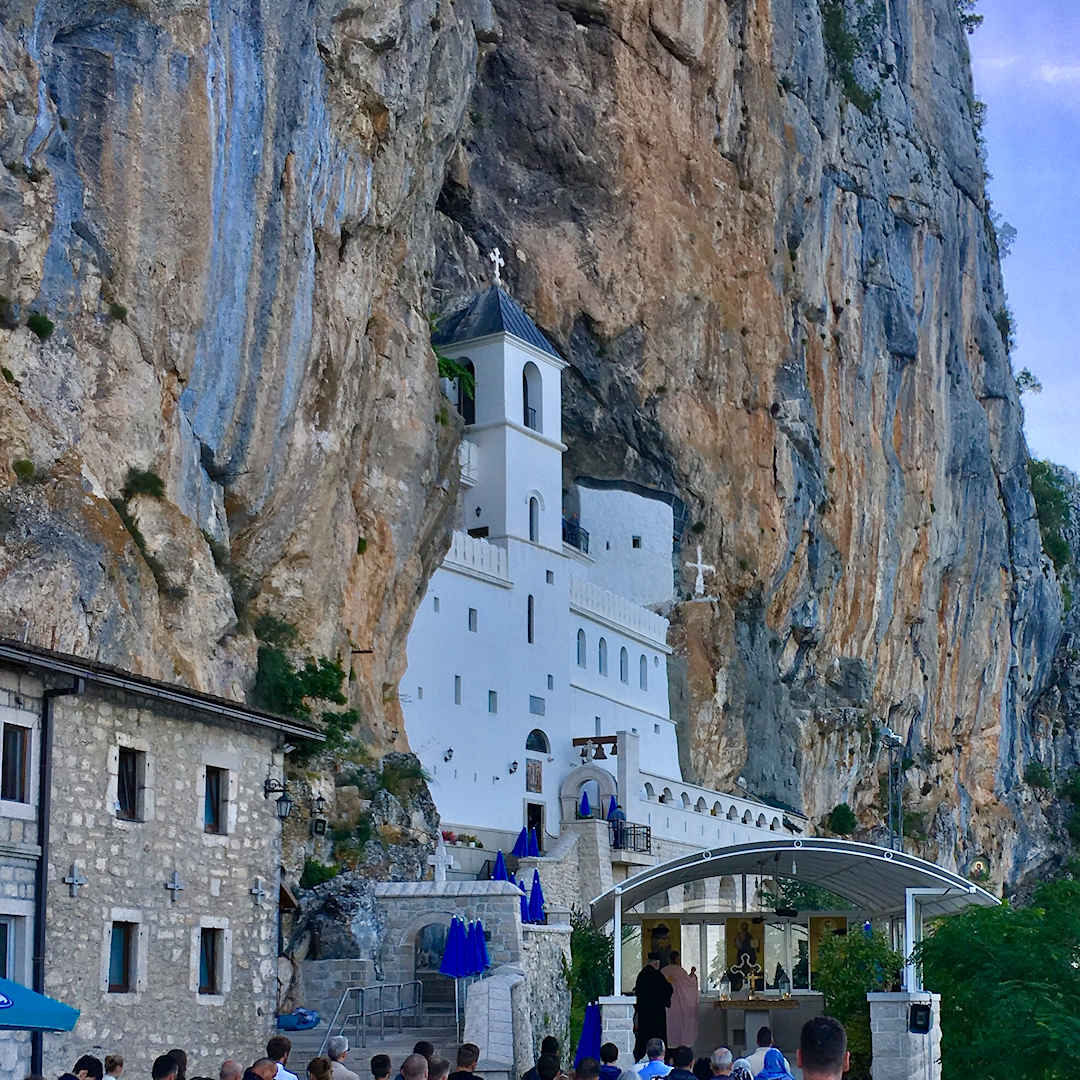
You can visit Ostrog Monastery on a day trip from Cetinje or overnight at the Monastery to experience the sunrise service
Days 7-10: (Stari) Bar, Ulcinj and Skadar Lake National Park
Cetinje to Bar
On to your third stop on our itinerary: the Southern Adriatic coast and Skadar Lake. The bus journey from Cetinje to Bar takes about 2 hours. Once in Bar, there are frequent connections by
- bus between Bar and Ulcinj (taking around 30 minutes) and
- train between Bar and Virpazar on Skadar Lake (taking 25 minutes).
Alternatively, you could hire a car for a day or two to explore the area more flexibly. If you hire a car, be aware that Montenegrin drivers (or Serbian drivers on holiday) are not the most courteous. Secondary roads tend to be narrow, requiring frequent stops to let oncoming traffic pass.

Stari Bar, the ancient walled city 5km from the modern-day port town, is well worth a visit
What to see and do in/around Bar
Stari Bar and Ulcinj
Most travellers to Montenegro explore Budva and Sveti Stefan. While beautiful, they are both very touristy. If you’re after a more offbeat experience, head further down the coast and explore the stretch of coast between Bar and the border with Albania and the area around Skadar Lake.
Bar is not the most exciting place, but its ancient Old Town is very worthwhile checking out, so visit Stari Bar [Google Maps location]. The old walled city is about 5km east of the modern-day port town (it is best to take a taxi to get there and walk back down). Travelling further south along the coast gets you to Ulcinj, its walled Old Town overlooking the harbour [Google Maps location] and a distinctly Albanian feel. The nearby Salt Pans [Google Maps location] – which date back to Roman times and are a bird(er’s) paradise – and the olive groves on the way to Valdanos Beach [Google Maps location] make for great days out on a bicycle.

Ulcinj's Old Town isn't as interesting as Stari Bar, but the town has welcoming locals and a distinctly Albania feel | Image courtesy of Wikimedia Commons
Skadar Lake and Pavlova Strana
North-east of Bar, explore the sprawling Skadar Lake with its carpets of water lilies and picturesque Pavlova Strana overlooking a bend in the Rijeka Crnojevića River. Boat excursions on Skadar Lake leave from the old bridge in Virpazar [Google Maps location], a tiny harbour settlement with its own train stop on the Bar-Belgrade Railway (a flat 1km walk away – Google Maps location).
The Pavlova Strana viewpoint and nearby Rijeka Crnojevića village can only be reached by car. For a gorgeous drive overlooking the lake, turn left off the M2 just after the Virpazar turnoff [Google Maps location]. Follow the road up the serpentines, through Komarno and Donja Sela, to Rijeka Crnojevića (a leisurely 24km drive – Google Maps location). From there, it’s a short 3.5km drive to the Pavlova Strana viewpoint [Google Maps location]. If you want to experience the meandering river from a boat, the excursions start in Rijeka Crnojevića next to the old footbridge. Return the same way you came or do a big loop, passing the southern outskirts of Podgorica before joining the M2 and crossing Skadar Lake on your way back to Bar.

Virpazar and Rijeka Crnojevića are the vantage points for boat excursions on Skadar Lake (and the Rijeka Crnojevića river)
Where to stay in Bar/Ulcinj
Bar is a port town and not very pretty. We preferred Ulcinj. That said, if you don’t want to hire a car, it is best to base yourself in Bar, as it’s easy to visit Ulcinj from there by bus and Skadar Lake by train (each is about 30 minutes away).
| Name | Property Features | Location | Type | Price Indicator | Book Now |
|---|---|---|---|---|---|
| El Sol Apartmani | Very close to train and bus station, yet quiet | Bar | Apartment | $$ | Book Now |
| Les appartements Prives Bar | Certain documented environmental practices implemented at property. 1100m from Bar train station Mountain views Fully equipped kitchen | Bar | Apartment | $$$$ | Book Now |
| Summer apartment | Balcony Washing machine Close to Seafront yet still walking distance to bus and train station | Bar | Apartment | $$ | Book Now |
| Apartmani Djurovic | Modern apartments in a central location overlooking the beach and Old Town | Ulcinj | Apartment | $ | Book Now |
Where to eat in (Stari) Bar, Ulcinj and around Skadar Lake
Narrowing it down to our top three wasn’t easy, but here they are:
- Restaurant Cevapdzinica Dino, a lovely family-owned restaurant on the cobbled street near the walled city in Stari Bar
- Byrektore Pelivan, an unassuming small local eatery in Ulcinj with delicious byreks
- Macalov Brijeg, a small café overlooking Skadar Lake on the road between Virpazar and Rijeka Crnojevića (requires car).
How to find the best deals on rental cars
Most of the time, we use public transport to get us around. But occasionally, hiring a car or scooter just makes it easier or gets us to places we couldn't go without a set of wheels. Whenever we do hire a vehicle, our first point of call are local rental providers. A quick Google Maps search shows who's near us. We then check the reviews and only contact those other travellers had good experiences with.
If we can't find anyone we're comfortable with, we search for deals on aggregator websites. We've used Rentalcars.com and DiscoverCars.com in the past and had only good experiences with them. Both partner with trusted brands like Hertz, Avis, Budget or Europcar (and in some locations even local providers) - so you can compare car hire options in a similar way you'd compare accommodation offers across Agoda and Booking.com.
Half day trip on the Bar-Belgrade Railway
The journey from Bar to the country’s north is one of Earth’s most incredible train journeys. After crossing Skadar Lake and leaving the capital, Podgorica, the train slowly ascends through deep river gorges into the mountains via myriads of tunnels and bridges (including the famous Mala Rijeka Viaduct).
Pending your travel time (between mid-April and mid-October), up to three train departures a day would allow you to experience the stunning scenery. The journey to Kolašin takes 2 1/2 hours (though it is often delayed by at least 30 minutes). Mojkovac is another 20 minutes further north. Check our Bar Belgrade Railway Guide for more details.
Bar to Belgrade Railway: A Journey Worth Taking?
Are you curious about one of Europe's most scenic train rides? Find out if the Bar to Belgrade railway is worth your time and money, what to expect along the way, and how to make the most of this epic adventure.
Where to eat in Kolašin or Mojkovac
On our itinerary, Kolašin/Mojkovac are only stopovers on your way to Žabljak. But if you’re hungry, you might want to check out any of these:
- Hermes, a welcoming restaurant at the edge of Kolašin, serves delicious, traditional food
- Vigor at Wulfenia Hotel, a highly-rated fine dining joint within the Wulfenia Hotel in Kolašin
- Poslastičarnica Buregdžinica “Zora”, unassuming local restaurant in Mojkovac serving delicious burek.
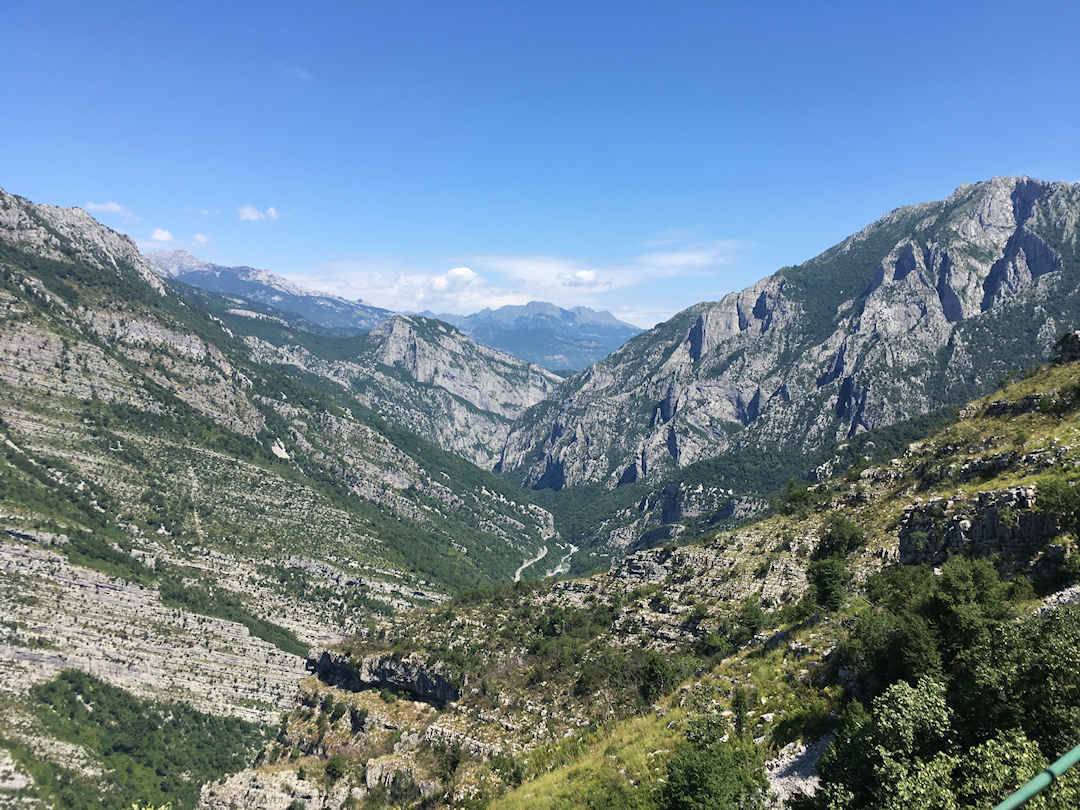
Don't miss it: The journey on the Bar-Belgrade Railway in Montenegro is one of the most amazing train rides on earth
Days 10-14: Žabljak, Durmitor National Park and Tara River Canyon
Kolašin or Mojkovac to Žabljak
Did you enjoy the train ride from the coast over Skadar Lake up into the mountains? And how different do Kolašin and Mojkovac feel? It’s more like Switzerland than Montenegro, with much more pleasant temperatures, even in summer.
There is no direct bus connection from Kolašin or Mojkovac to Žabljak. Instead, you have the following two options:
- Via Podgorica: Take the bus or train back to Podgorica and the bus from there to Žabljak. There are multiple connections a day, and you get to see the stunning mountain scenery twice (albeit from the highway if you take the bus). The journey costs EUR17-18.50 (plus fees) and takes 4 1/2 hours from Mojkovac (4 hours from Kolašin) – not including wait time in Podgorica.
- Via Pljevlja: Continue your journey by bus to Pljevlja and change there for the bus to Žabljak. There is only one connection per day. However, the journey will allow you to experience the crossing of the famous Tara Bridge/Đurđevića Tara Bridge [Google Maps location] – another engineering masterpiece. This journey costs EUR14 (plus fees) and takes 3 1/2 hours from Mojkovac (4 hours from Kolašin) – not including wait time in Pljevlja.
Make sure to check the bus connections and train timetable before your trip.

Travelling by bus via Pljevlja to Žabljak will see you crossing the Tara Bridge, a masterpiece of engineering | Image courtesy of Laurynas Zizys on Unsplash
What to see and do in/around Žabljak
Durmitor National Park Hikes
Žabljak is the gateway to Durmitor National Park. A UNESCO site since 1980, the park is home to countless challenging but rewarding hiking trails.
Our favourite was this 16km loop to the Ledena Pecina Ice Cave. With more than 930 metres in elevation gain and some near-vertical sections, this was one of the most demanding hikes we’ve ever done, but the stunning scenery made more than up for the effort. We recommend doing the loop in a clockwise direction as there is a near vertical section just after the ice cave (which is easier to do down than up). As the name suggests, the cave has ice formations all year round (you can even see them from above the cave). While the hike is already rewarding, some hikers enter the cave to check out the ice formations close-up. The path down, however, is very slippery, so enter at your own risk.
Like Kolašin and Mojkovac, the temperatures in Žabljak and Durmitor National Park are much more pleasant, with a comfortable 20 degrees Celsius at the height of summer, so bring warmer layers, especially if you come in spring or autumn. For climate information all year round, check out Weatherspark.

A UNESCO Heritage site since 1980, Durmitor National Park is home to challenging hiking trails with stunning scenery
Durmitor Ring Bike Ride
If you feel more comfortable in the saddle, you could hire an eBike/MTB [Google Maps location] and ride the 77km Durmitor Ring, one of Montenegro’s most epic drives/rides. We recommend doing it in an anti-clockwise direction as this will allow you to cover the steepest section, just after Bosača, first. With an elevation gain of 2,040 metres, expect to take around 5 hours (not including breaks).

You can also enjoy the beautiful Dinaric landscapes along the 77km Durmitor Ring road | Image courtesy of Laurynas Zizys on Unsplash
Tara River Gorge Rafting Adventures
Tara River Gorge—you may have crossed it via the Đurđevića Tara Bridge—which cuts through the northern part of Durmitor National Park. At its deepest point, 1,300 metres deep, the Tara River Gorge is Europe’s second deepest river canyon (and third deepest in the world after the Sulak Canyon in Russia and the Grand Canyon in the United States). The canyon is a popular rafting hotspot, boasting over 100 rapids and cascades with water from 14 tributaries.

Among the deepest canyons in the world, the Tara River Gorge is a favourite rafting hotspot | Image courtesy of websiteproud on Pixabay
Where to stay in Žabljak
Žabljak is the gateway to Durmitor National Park, though the park entrance is a 2-kilometre walk southwest of the small town. Keep that in mind when you select your accommodation. Here are my Žabljak accommodation recommendations:
| Name | Property Features | Location | Type | Price Indicator | Book Now |
|---|---|---|---|---|---|
| Bozovic Studio Apartman | Entire place is yours, parking, shuttle service, kitchen facilities | Zabljak | Apartment | $$ | Book Now |
| Cozy lux mountain apartment | Entire place is yours, breakfast available, parking, views, pet friendly | Zabljak | Apartment | $$$ | Book Now |
| Villa Jezero 4 | Entire place is yours, parking, views, family friendly, kitchen facilities | Zabljak | Apartment | $$ | Book Now |
Where to eat in Žabljak
Being more a village than a town, Žabljak lacks many good dining options. The local Pekara/Bakery, behind the Voli Supermarket, was always packed with people, but our absolute favourite was the Durmitor Inn, a small family business that has since permanently closed. Other worthwhile options in town and along the ring road include:
- Mountain Bite is a small outdoor eatery serving delicious sandwiches (and Lavazza coffee).
- Café Paradiso, opposite the bus station
- Vilina Jama is a small coffee shop/bar along the Durmitor Ring that serves Turkish coffee, cold drinks, and local cheese.
Most eateries in Žabljak are only open during the summer season, from about mid-April to mid-September. If you’re visiting during other times, be prepared to fully self-cater.
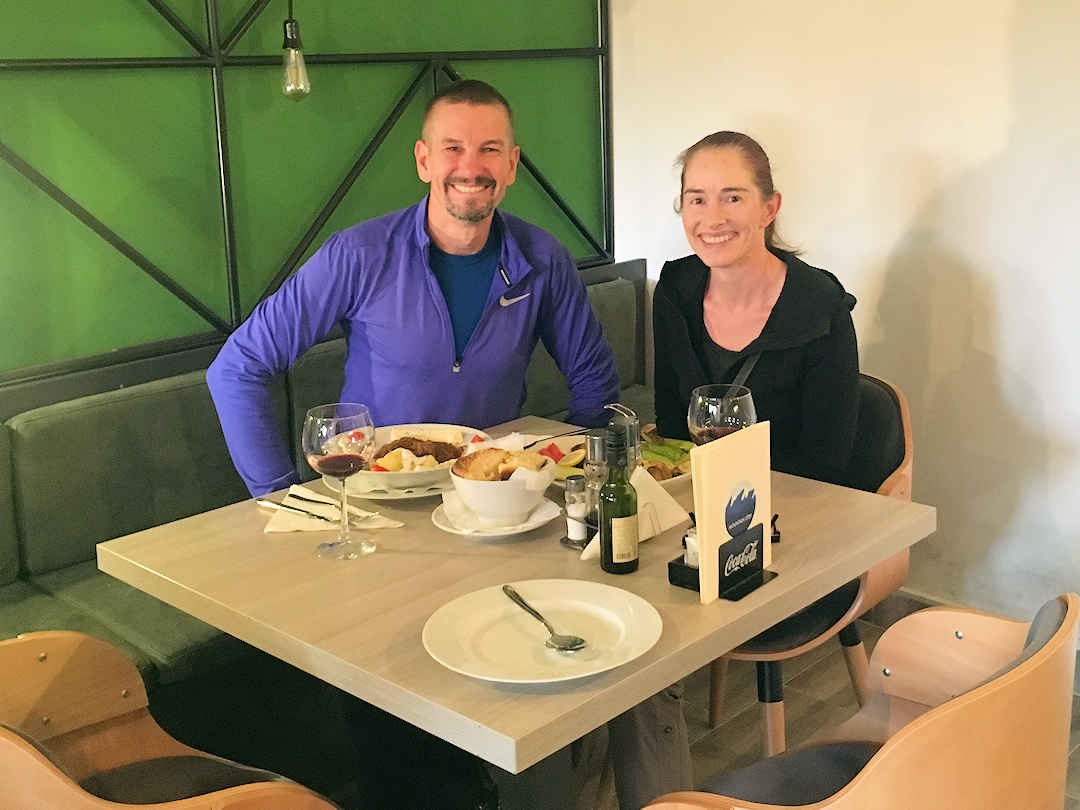
Our favourite restaurant in Žabljak was the Durmitor Inn (now sadly closed) - delicious food, friendly service and very affordable
Žabljak to the Airport
All great adventures must end, and our Montenegro highlights tour is no exception.
If you fly out of Podgorica (TGD), frequent buses between Žabljak and Podgorica’s Intercity Bus Station take approximately 2 1/2 hours. From there, go to the airport using the above instructions in reverse.
There are also seasonal intercity buses between Žabljak and Kotor/Tivat. So if you’re leaving from Tivat (TIV), first take the intercity bus (taking up to 4 hours), then follow our instructions above in reverse. Likewise, if you’re flying out of Dubrovnik (DBV), travel to Kotor/Tivat and then take a taxi/private transfer. As the buses between Žabljak and Kotor/Tivat are not frequent (and delays are common), confirm the up-to-date timetable at the Bus Station in Kotor before you leave the city on day 4. If the schedule doesn’t align with your flight, travel via Podgorica instead (or, even better, book your return flight from Podgorica).
What to pack for your Montenegro trip
Given Montenegro’s topography, temperatures can vary significantly depending on where you go. We visited the country in July, with 30+ degrees Celsius along the Adriatic coast but a much cooler 20 degrees Celsius in Durmitor National Park. Check Weatherspark for year-round climate data at your destination.
Check out our recommended carry-on packing lists if you want to be prepared for any weather and still pack light.
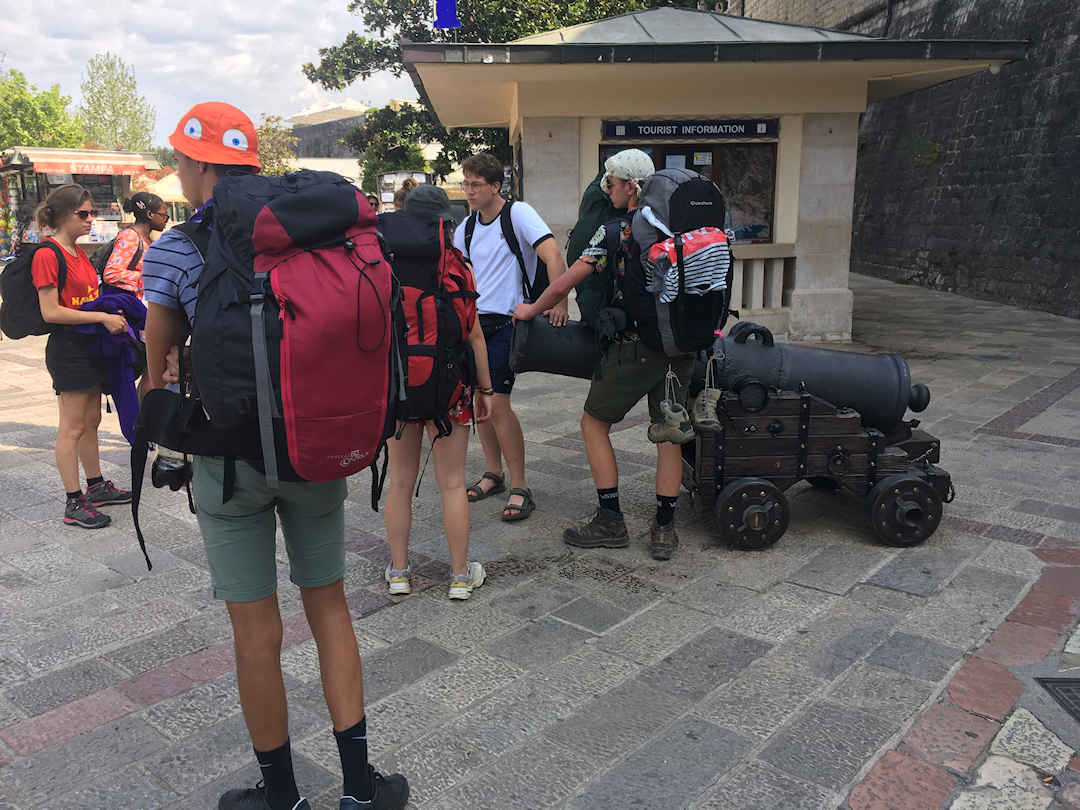
Don't bring the kitchen sink when exploring Montenegro - Check our packing lists to lighten your load
What food to try in Montenegro
When visiting Montenegro, make sure you try some typical Montenegrin or Balkan dishes, including
- Cevapi (small, minced meat sausages made without skin)
- Burek (filo pastry filled with meat, cheese or spinach) – locals have it with ajran, a savoury yoghurt drink
- Ispod Saca (veal, lamb or goat meat slowly roasted under hot coals with potatoes, carrots, and onions)
- Buzara (a seafood stew with red or white wine sauce)
- Gavice (small fried fish)
- Grilled fish from Skadar Lake, and
- local varieties of cheese (for example, Durmitorski skorup, Njeguški sir or Pljevaljski sir) and prosciutto (the village of Njeguši between Kotor and Cetinje is famous for it).
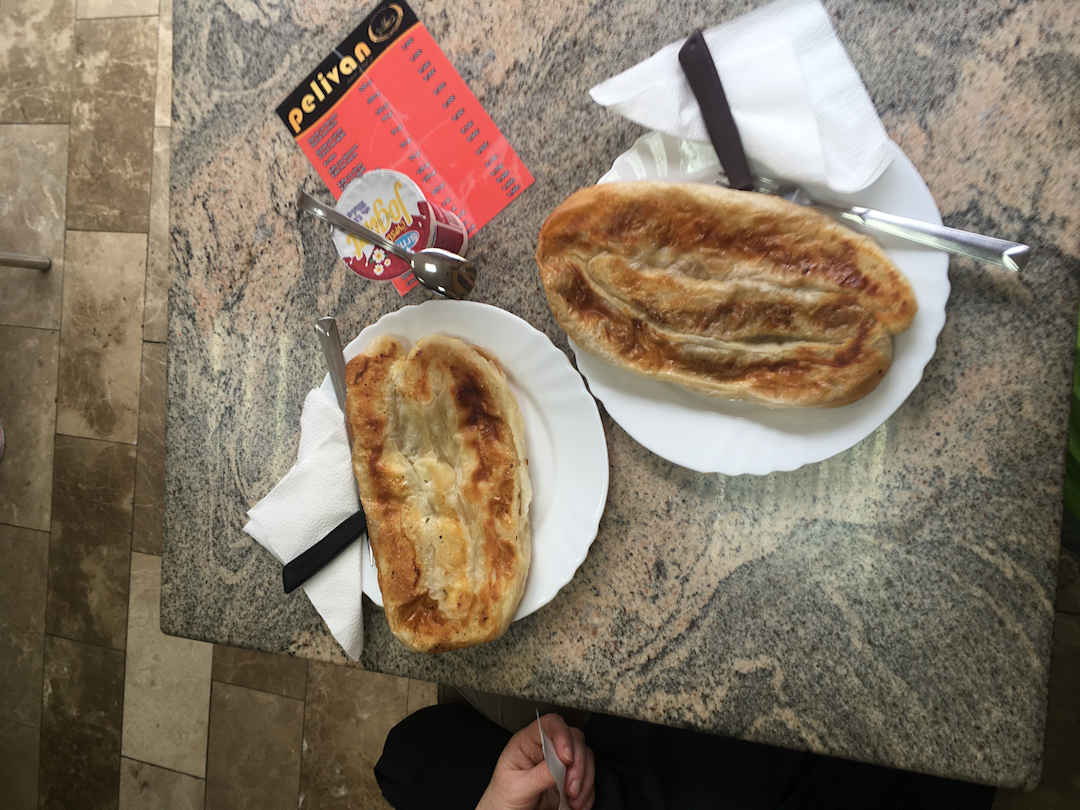
Make sure you try some typical Montenegrin or Balkan dishes, including Burek
Have you been to Montenegro?
What tips would you add for first-time visitors to this culturally diverse country? If you haven’t been yet, did our travel guide whet your appetite? What other questions do you have?
Before you go, if you liked our article and found it helpful, we would appreciate it if you could share it with your friends and family via the Share buttons below. Even better: Leave a short review on Trustpilot or Google, which would help us further build our online reputation as a (trustworthy and helpful) travel and lifestyle blog.

